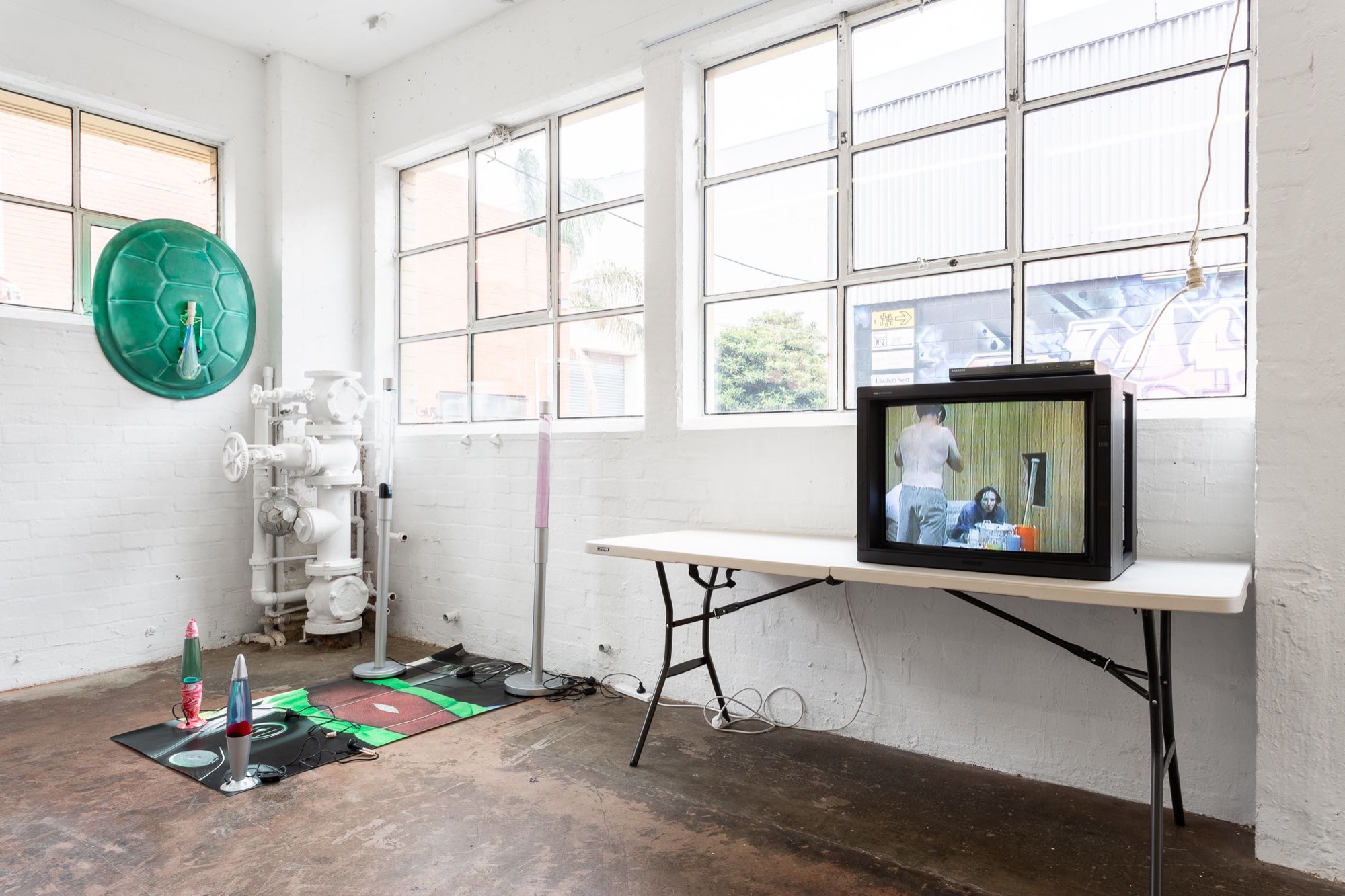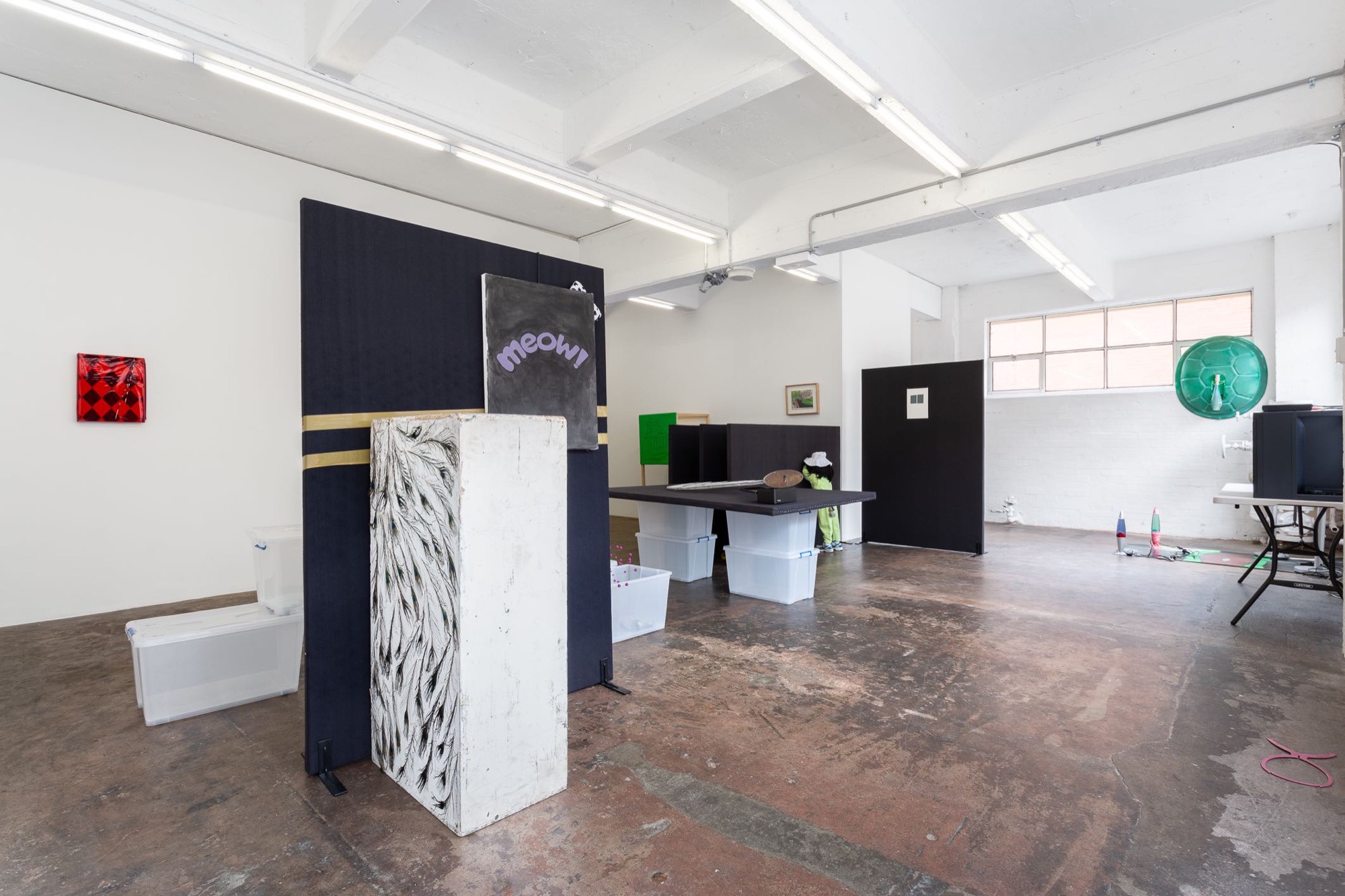Spencer Lai: A smile forms into a grimace; Matilda Davis: Too Many Dinner Parties
Francis Plagne
The fascination of bad taste continues to exert its somewhat mysterious pull on certain sub-scenes in the Melbourne artworld. Spencer Lai’s current show in the front room at Bus Projects—part of the gallery’s ‘With Compliments’ series of exhibitions that invites artists to present their own work alongside that of their contemporaries and influences—is a spectacularly messy affair that gives us a representative sampling of the new frontiers of bad taste being explored by younger artists in this city. Shown over two iterations, it began as primarily an exhibition of Lai’s work alongside pieces by Lou Hubbard and a video by Paul McCarthy and Mike Kelley, before being expanded in its second form with the addition of work by a number of other artists, including Kate Meakin, Hana Earles and Elizabeth Newman. (I saw only the second iteration). Like much of the work exhibited in galleries such as Punk Café and Suicidal Oil Piglet over the last couple of years (and at Y3K before them), the work on display here is decidedly post-Cologne, hearkening back to the jokey, irreverent and alternately charming and somewhat annoying ‘insider’ tone that characterised the scene around figures like Martin Kippenberger and Albert Oehlen in the 1980s: an empty flat screen TV box is messily taped to a partition wall; a canvas with ‘meow’ painted on it is decked out with soft toy cat ears and a tail; a soccer ball is wedged in between the water pipes.

Of course, pushing at the barriers of good taste has always been part of the aesthetic gambit of vanguard taste, at least since the Futurists proclaimed a preference for wrestling matches over the masterpieces of European art. But the inevitable recuperation of bad taste as part of acceptable taste necessitates that this vanguard exercise cannot remain static but must strive to transgress itself if it wishes to retain its status as a challenge. Thus, for the scene represented by Spencer Lai’s show, the classically avant-gardist reference to aspects of vernacular culture that transgress the moral standards imposed by good taste (pornography, for example) or that exemplify the absolutely commonplace (Warhol’s Brillo boxes) is refused in favour of an object like a lava lamp (a number of which figure into one of Lai’s untitled assemblages), which does neither of these things. Certainly not culturally transgressive, nor truly ugly, the lava lamp is, in its own tasteless and meaningless way, attractively designed. Not really an emblem of generic mass culture, with its connotations of commodified post-hippie aesthetics the lava lamp is a bit too personal as a consumer choice to act as a signifier for the utterly commonplace. (It is telling in this regard that the material description of Lai’s piece specifies that the lava lamps used are ‘personal lava lamps, family lava lamps, Lou’s lava lamps’). It is precisely this uncomfortable mid-way point, this refusal to definitely cross the threshold into impersonality, ugliness, and banality—qualities comfortably enshrined within avant-garde aesthetics—that, paradoxically, means that the selection of the lava lamp reads as an authentic exercise in vanguard bad taste.

The most interesting aspect of the work gathered in Lai’s exhibition is the way it pushes against the sort of late-modernist elegance that marks the display of found objects in the work of international artists like Gedi Sibony or, locally, Elizabeth Newman (whose refined Ellsworth Kelly-esque collages are thus somewhat out of place in the exhibition). Where Newman might present a log or a piece of concrete in a way that invests it with the aura of an abstract sculpture, the work here seems displayed in such a way as to deliberately rob it of a sense of presence. The gallery is crowded with trestle tables and partition walls that generate a sense of amateurishness (deliberate, of course) and cause the works displayed on the floor to read as invocations less of post-minimalist sculpture than of a messy teenage bedroom.

The more compelling works in the show integrate modes of display into the work itself. In the second version of Lai’s untitled, objects that were shown on a flat surface supported by plastic storage tubs in the first version are simply piled into one of the open tubs, now shown stacked into two rows. In Hana Earles’ Balenciaga Marxist, a very sad-looking plinth becomes a sculpture by having two of its surfaces covered in peacock feathers. In addition to the bad-boy flippancy of Oehlen and Kippenberger, the work of another figure involved in the 1980s Cologne scene comes to mind here: the Austrian Heimo Zobernig, best known for starkly reductive exhibitions that might consist of nothing other than painting the gallery floor black and witty gestures such as displaying his sculptures on the packing crates in which they were shipped to the gallery. Like Zobernig, what Lai and Earles do here in focussing our attention on how the work is displayed is not really “institutional critique” in any meaningful sense but rather a variant of modernist self-reflexivity: a bringing to consciousness of material aspects of the display of the artwork that usually go unnoticed, and an illumination of these aspects as possible areas of questioning, variation and play.
The work displayed in the small solo show by Matilda Davis in the next room, Too Many Dinner Parties, also deliberately courts kitsch. Her six lovingly crafted oil paintings, each identically sized at 16 x 24 inches, offer a sort of high school surrealism, packed with symbolic detail and miniature incident. Dogs stick their heads out of mounds of earth; a human figure with a ram skull head is tied to a rock in bondage gear; bones are neatly laid out flat on the ground; a rope attaches the Islamic crescent moon to a crucifix stuck in the dirt, itself attached to circle of demented dancing figures. Adding to the air of kitschy personal occultism, the artist sometimes signs her name backwards (Sivad Adlitam) and a number of works feature the year 1996 written in roman numerals (the artist’s birth date, perhaps).

Davis’ work seems deliberately to refer to debased forms of fantastical art—the imagery of Dungeons & Dragons, even the world of RPG games like Zelda—and the text accompanying the exhibition room sheet mentions trading cards as an aesthetic model. But one can equally draw up an exalted historical pedigree for her work, one that will include names that rarely come to mind when looking at contemporary art. Her use of barren desert landscapes as a geographical metaphor for haunted interiority calls to mind canonical surrealists like Dali and Tanguy, or even someone as eminently unfashionable as Russell Drysdale. The tiny figures that populate her doll-house world, onto which she prefers to give us a distant, somewhat elevated view, cannot help but recall the disconcerting work of naïve artists like Gertrude O’Brady, even the stickmen of L. S. Lowry. Perhaps most evidently, her casts of cartoonish animals and fondness for odd wispy forms that look like scarves blowing in the wind evince the strong influence of Leonora Carrington. In fact, far from being exclusively concerned with the signifiers and styles of popular culture, Davis’ work teems with explicit references to high art. The rope attached to the crescent moon in A Landscape Perhaps seems to deliberately mimic a similar image in a painting by Chicago surrealist Gertrude Abercrombie (Moored to the Moon, 1963), while the circle of dancing figures in the same work echoes the form of Matisse’s pair of Dance paintings from 1909-1910. (A painting in Davis’ show earlier this year at Irene Rose represented Matisse’s work in miniature hanging on the outside of a sort of pagoda, above a couple with heart-shaped blobs for heads, a mess of wild pumpkins and a dog chained to a lemon tree, among other things).
The sides of each of Davis’ canvases are decorated with ribbons, sewing trims and plastic flowers, and two of the paintings, for whatever reason, have freshwater pearls sitting on top of them. These aspects of deliberately naïve craft further emphasise the kitsch dimension of the work, and act as mocking reminders of the materiality of the painting, providing a link to the slacker object sculptures in Spencer Lai’s show. But, for me, this is something of a misstep. The ironic, deliberately debased aspect of Davis’ work is certainly the least interesting thing about it. Irony, of course, is fundamentally distancing, separating the artist from what they might produce, transforming the work into a gesture. In this distancing it insists on a sort of knowledge on the part of the artist: from a distance, they look upon what they have done and know what it is. To refuse such ironic distance, while it skirts the risk of earnestness, is also to insist on the role of unknowing in the work of art, the necessity of being too close to what one has done to know what it really is. The strongest aspect of Davis’ work is not its ironic self-sabotage but its sense of a subjective immersion in fantasy, the creation of an obscure symbolic language that the artist herself perhaps does not entirely understand. While it would be customary, in the case of such a young artist, to look forward to their future establishment of a more definitive style based on a more solid self-consciousness about their practice, my hope would be exactly the opposite—that Davis might be able to hold on to not knowing exactly what she is doing.
Francis Plagne is a writer and musician from Melbourne.


